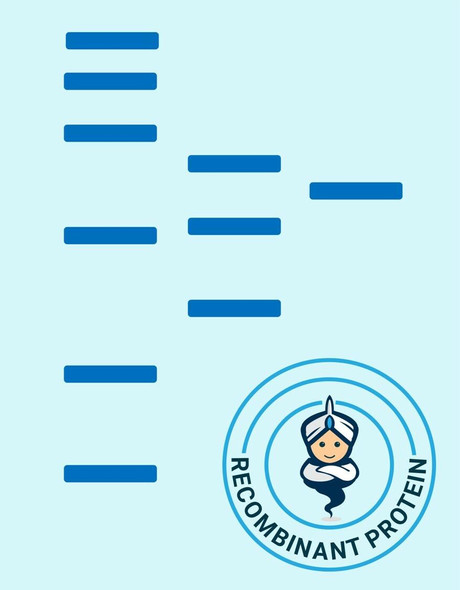Description
| Product Name: | Human FGB Recombinant Protein |
| Product Code: | RPPB3536 |
| Size: | 20µg |
| Species: | Human |
| Target: | FGB |
| Synonyms: | Fibrinogen beta chain, Fibrinopeptide B, Fibrinogen, BBeta Polypeptide,Epididymis Secretory Sperm Binding Protein Li 78p, HEL-S-78p. |
| Source: | Escherichia Coli |
| Physical Appearance: | Sterile Filtered colorless solution. |
| Formulation: | FGB protein solution (1mg/ml) containing 20mM Tris-HCl buffer(pH8.0) and 10% glycerol. |
| Stability: | Store at 4°C if entire vial will be used within 2-4 weeks. Store, frozen at -20°C for longer periods of time.�For long term storage it is recommended to add a carrier protein (0.1% HSA or BSA).�Avoid multiple freeze-thaw cycles. |
| Purity: | Greaterthan 85.0% as determined by SDS-PAGE. |
| Amino Acid Sequence: | MGSSHHHHHH SSGLVPRGSH MGSDNENVVN EYSSELEKHQ LYIDETVNSN IPTNLRVLRS ILENLRSKIQKLESDVSAQM EYCRTPCTVS CNIPVVSGKE CEEIIRKGGE TSEMYLIQPD SSVKPYRVYC DMNTENGGWTVIQNRQDGSV DFGRKWDPYK QGFGNVATNT DGKNYCGLPG EYWLGNDKIS QLTRMGPTEL LIEMEDWKGDKVKAHYGGFT VQNEANKYQI SVNKYRGTAG NALMDGASQL MGENRTMTIH NGMFFSTYDR DNDGWLTSDPRKQCSKEDGG GWWYNRCHAA NPNGRYYWGG QYTWDMAKHG TDDGVVWMNW KGSWYSMRKM SMKIRPFFPQ Q |
FibrinogenBeta Chain 9 (FGB) is the beta component of fibrinogen, a blood-borneglycoprotein composed of 3 pairs of nonidentical polypeptide chains. When vascularinjury accrues, fibrinogen is cleaved by thrombin to form fibrin which is foundin abundance in blood clots.
FGB Human Recombinant produced in E.Coli is a single,non-glycosylated polypeptide chain containing 351 amino acids (164-491a.a) andhaving a molecular mass of 40kDa.�FGB is fused to a 23 amino acid His-tag at N-terminus& purified by proprietary chromatographic techniques.
| UniProt Protein Function: | FGB: Fibrinogen has a double Function: yielding monomers that polymerize into fibrin and acting as a cofactor in platelet aggregation. Defects in FGB are a cause of congenital afibrinogenemia (CAFBN). This rare autosomal recessive disorder is characterized by bleeding that varies from mild to severe and by complete absence or extremely low levels of plasma and platelet fibrinogen. Patients with congenital fibrinogen abnormalities can manifest different clinical pictures. Some cases are clinically silent, some show a tendency toward bleeding and some show a predisposition for thrombosis with or without bleeding. |
| UniProt Protein Details: | Protein type:Cell surface; Secreted; Secreted, signal peptide; Adaptor/scaffold Chromosomal Location of Human Ortholog: 4q28 Cellular Component: extracellular space; cell surface; fibrinogen complex; extracellular region; plasma membrane; cell cortex; vesicle; external side of plasma membrane Molecular Function:protein binding, bridging; protein binding; chaperone binding; cell adhesion molecule binding; structural molecule activity; receptor binding Biological Process: protein polymerization; platelet activation; extracellular matrix organization and biogenesis; positive regulation of heterotypic cell-cell adhesion; cell-matrix adhesion; signal transduction; platelet degranulation; cellular protein complex assembly; positive regulation of protein secretion; positive regulation of vasoconstriction; innate immune response; response to calcium ion; blood coagulation; positive regulation of exocytosis Disease: Afibrinogenemia, Congenital; Dysfibrinogenemia, Congenital |
| NCBI Summary: | The protein encoded by this gene is the beta component of fibrinogen, a blood-borne glycoprotein comprised of three pairs of nonidentical polypeptide chains. Following vascular injury, fibrinogen is cleaved by thrombin to form fibrin which is the most abundant component of blood clots. In addition, various cleavage products of fibrinogen and fibrin regulate cell adhesion and spreading, display vasoconstrictor and chemotactic activities, and are mitogens for several cell types. Mutations in this gene lead to several disorders, including afibrinogenemia, dysfibrinogenemia, hypodysfibrinogenemia and thrombotic tendency. Alternatively spliced transcript variants encoding different isoforms have been found for this gene. [provided by RefSeq, Jun 2014] |
| UniProt Code: | P02675 |
| NCBI GenInfo Identifier: | 399492 |
| NCBI Gene ID: | 2244 |
| NCBI Accession: | P02675.2 |
| UniProt Secondary Accession: | P02675,Q32Q65, Q3KPF2, A0JLR9, B2R7G3, |
| UniProt Related Accession: | P02675 |
| Molecular Weight: | 55,928 Da |
| NCBI Full Name: | Fibrinogen beta chain |
| NCBI Synonym Full Names: | fibrinogen beta chain |
| NCBI Official Symbol: | FGB�� |
| NCBI Official Synonym Symbols: | HEL-S-78p�� |
| NCBI Protein Information: | fibrinogen beta chain; fibrinogen, B beta polypeptide; epididymis secretory sperm binding protein Li 78p |
| UniProt Protein Name: | Fibrinogen beta chain |
| Protein Family: | Fibrinogen |
| UniProt Gene Name: | FGB�� |
| UniProt Entry Name: | FIBB_HUMAN |






